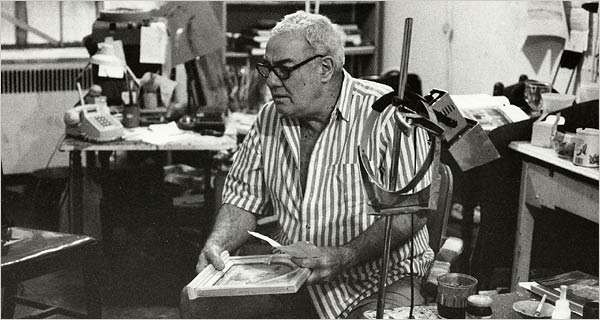
| Contact & Showroom |
Robert Kulicke - The Framer's Framer

In 1947 a young man, home from the war studying art and advertising design, took his first steps at making picture frames. His early endeavors were well received and it encouraged him to peruse a career as a frame maker. Later Robert Kulicke would admit at the time he had no idea of the extent of his ignorance, "being reasonably intelligent, persuasive, enthusiastic and totally ignorant at once." That enthusiasm led him to take advantage of the GI bill and travel to Paris to study his craft. He was lucky enough to study painting with Fernand Leger in the morning and apprentice with frame carvers and gilders in the afternoon. By his second year there he was spending more and more time at the Louvre teaching himself the history of frames. When he returned to New York he continued to study frames and their relationship to architectural design at the 42nd Street Library. By 1951 Robert Kulicke the frame maker was open for business. He began developing narrow wood frames with gilded surfaces using strainer supports to reinforce them. In 1953 he developed the floater frame for Knoll Associates; it was not a new idea, but his good design sense made it better looking and more user friendly. He had the unique ability to keep things simple; he once said: "to aim at originality head on is the only certain way of never arriving there - true originality is a byproduct of the search for a technical aesthetic solution to a technical and aesthetic problem" The world of modern art he was living in had many technical and aesthetic problems to be solved and he jumped right in. In the late fifties he created the welded aluminum frame for the Museum of Modern Art, a polished metal frame elegant and strong enough for the new powerful works of art. It was aesthetically based on the Barcelona chair by Mies Van de Rohe, a masterpiece of 20th century design. Indeed, the aluminum frame was a game-changer in the industry, suddenly thin was in. He then developed the plexibox for the photography department at MOMA; a solution to the technical problem of making a frameless frame that is dust proof. Meanwhile, he was putting all that knowledge he had acquired on the history of frames to good use by mastering the art of making period reproduction frames. His attention to authenticity led many of his frames to hang in the finest museums in the country including the National Gallery of Art and the Metropolitan Museum. Kulicke's generosity with his skills and knowledge would reach well into the future as he passed them on to many of today's leading gilders and frame makers. In 1967 he revolutionized the frame industry with the metal section frame, an idea he had been working on since he first brazed extruded aluminum to make his classic frame. The corner joint design made picture frames affordable just as baby boomers were starting to collect prints and posters. There are few homes today that do not have some variation on the metal section frame. For all he accomplished as a frame maker it was not his only passion. The New York Times got it right; in a 2007 obituary it called him "a painter, goldsmith, teacher, businessman and designer who changed the look of postwar art by modernizing frame design". The pride we feel today as framemakers has a great deal to do with the legacy he left behind. For me Robert Kulicke will always be the framer's framer. |
|